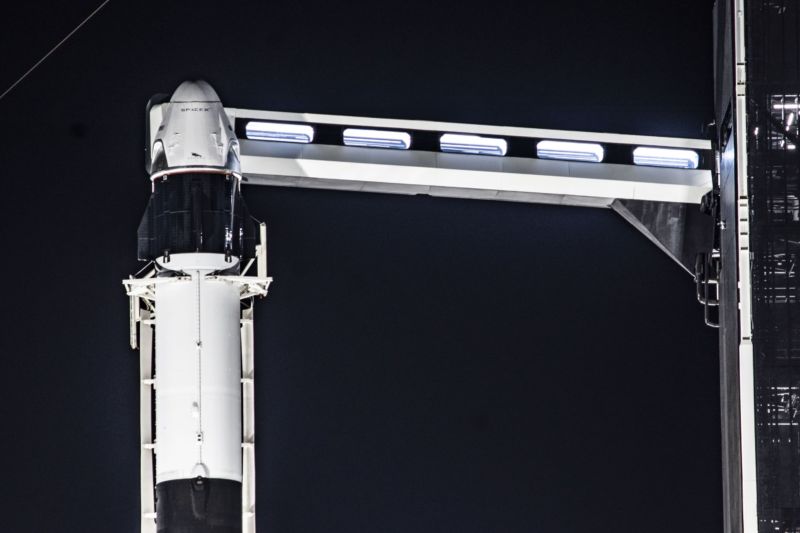
Officials from NASA and SpaceX said final preparations were underway for a critical flight test of Crew Dragon's launch escape system on Saturday morning from Kennedy Space Center in Florida. The four-hour launch window opens at 8am ET (13:00 UTC), and SpaceX indicated it may use much of that time to find an ideal slot due to weather conditions.
At the beginning of the launch window, weather at the pad should be ideal, but forecasters have concerns about offshore winds and waves. Later in the morning on Saturday, weather at the recovery site is expected to improve, which means the launch may well slip closer to noon than the top of the window. SpaceX may also seek to extend the window, if necessary. If the launch slips a day, conditions are reversed Sunday, with less favorable weather at the launch site but better conditions offshore.
"It’s a nice dance between launch weather, optics, winds, and waves offshore," Mike McAleenan, launch weather officer with the Air Force's 45th Weather Squadron, said during a briefing on Friday.
A huge test
SpaceX's Benji Reed said the company has completed more than 700 tests of the SuperDraco thrusters that will power Dragon's escape system on Saturday. The thrusters will pull the system away from the Falcon 9 rocket during the simulated emergency. This launch-escape test follows a pad-abort test of the launch escape system in 2015.
Saturday's test will be short. At 84 seconds after the rocket blasts off, its Merlin engines will shut down, and the eight SuperDraco thrusters on board Crew Dragon will fire for about 10 seconds to rapidly pull the spacecraft away from the rocket. Two mannequins will be on board to record forces inside the cabin, which are not expected to exceed 4Gs.
"On launch day, we're hoping for it not to be exciting," said NASA's Kathy Lueders, manager of the commercial crew program for NASA, which is funding development of private spacecraft to deliver its astronauts to the International Space Station. "We are purposely failing a launch vehicle to make sure our abort system works."
After coasting to the highest point of its arcing flight, the Crew Dragon trunk will separate, and the capsule will orient itself for a return to Earth. First the drogue and then the main parachutes will deploy, which should happen about five minutes after launch. Air Force personnel as well as members of the SpaceX recovery team will await Crew Dragon in the ocean.
Should SpaceX successfully complete this flight, it will be that much closer toward launching astronauts Doug Hurley and Bob Behnken on the vehicle's first crewed mission. The date of that flight, which could come as soon as this spring, will be set after NASA works through data from this in-flight abort test as well as other tests conducted by the California-based company.
"We’ve got work to do, but honestly getting this test behind us is a huge milestone," Lueders said.
Bye, bye booster
The Falcon 9 rocket's first stage will not be recovered. It has already flown three missions. This is the very first Block 5 version of the Falcon 9 rocket that SpaceX built and launched, with missions in May, August, and December 2018. It is likely to break up during Dragon's energetic escape and will not be recovered. This breakup may occur shortly after Dragon separation or upon reentry from the upper atmosphere. The second stage will be fully fueled, but since it will not be used during the flight, it will have a mass simulator instead of an actual Merlin vacuum rocket engine.
This test flight will feature an upgraded parachute system for the Dragon spacecraft, called Mark 3 parachutes. To meet NASA's requirements for the upgraded parachutes, SpaceX performed 10 tests of the Mark 3 parachutes during the last couple of months of 2019. Lueders said the company will do a few more "system level" tests of the parachutes before the first crewed launch.
The webcast below should begin about 15 minutes before the launch window opens on Saturday morning.
Bagikan Berita Ini














0 Response to "SpaceX will shut down its rocket mid-flight to test Dragon’s escape system - Ars Technica"
Post a Comment